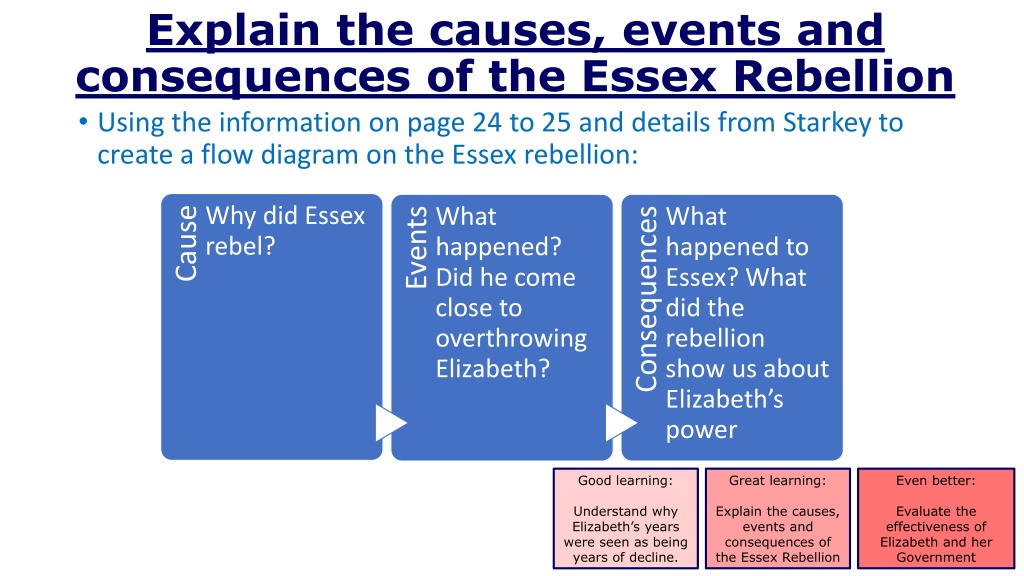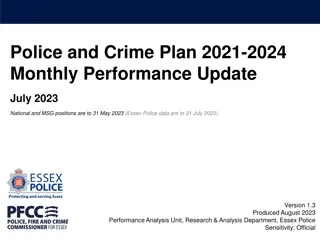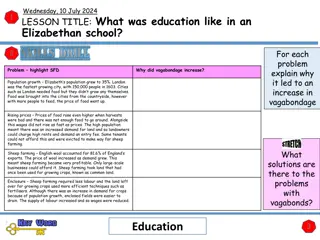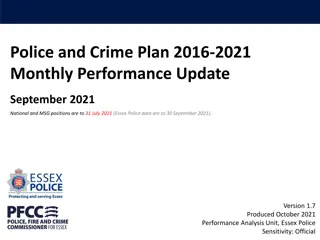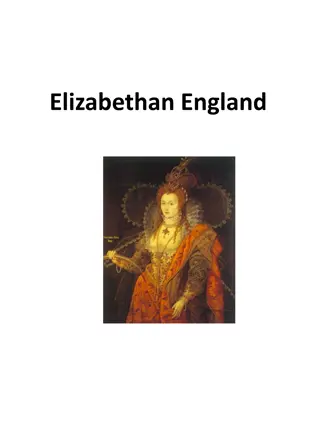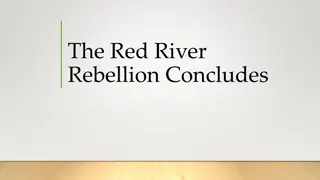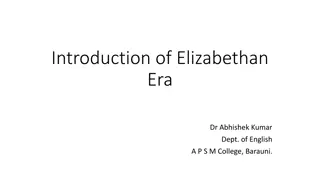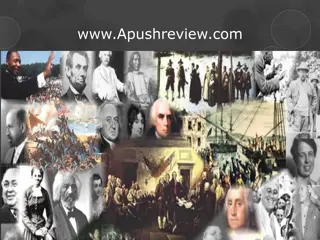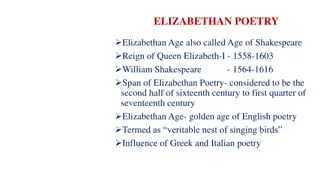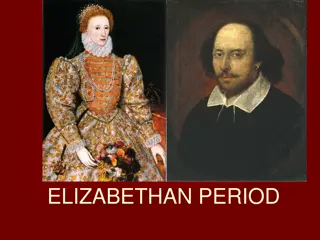Understanding the Essex Rebellion and Elizabethan Decline
Explore the causes, events, and consequences of the Essex Rebellion and evaluate its impact on Elizabeth and her government, shedding light on why the final years of Elizabeth's reign were viewed as a period of decline. Delve into societal changes, living standards, and cultural advancements during Elizabethan England's Golden Age.
Download Presentation

Please find below an Image/Link to download the presentation.
The content on the website is provided AS IS for your information and personal use only. It may not be sold, licensed, or shared on other websites without obtaining consent from the author. Download presentation by click this link. If you encounter any issues during the download, it is possible that the publisher has removed the file from their server.
E N D
Presentation Transcript
Explain the causes, events and consequences of the Essex Rebellion Using the information on page 24 to 25 and details from Starkey to create a flow diagram on the Essex rebellion: CauseWhy did Essex EventsWhat Did he come close to overthrowing Elizabeth? ConsequencesWhat show us about Elizabeth s power rebel? happened? happened to Essex? What did the rebellion Good learning: Great learning: Even better: Understand why Elizabeth s years were seen as being years of decline. Explain the causes, events and consequences of the Essex Rebellion Evaluate the effectiveness of Elizabeth and her Government
Understand why Elizabeths years were seen as being years of decline. Elizabeth s reign is said to have included 30 years of success and 15 years of failure. In 1588, 30 years into Elizabeth s reign the Spanish Armada was defeated and England had seen 30 years of very stable Government with very few changes to the Privy Council. However one by one Elizabeth started to lose her trusted councillors: - Dudley died in 1588, Walsingham in 1590, Hatton in 1591 and Cecil in 1598 (he had been very ill for many years but Elizabeth would not let him resign) She felt these losses and became angry, depressed and bad tempered. The young councillors who replaced those who died (William Cecil s son Robert Cecil and Dudley s step-son the Earl of Essex) were not as loyal to Elizabeth. It was now clear that Elizabeth was getting old, would not marry and would not have children. People started to think about who the next monarch would be. Many social and economic problems had not been with dealt with and there had been a lack of reform. Parliament challenged Elizabeth over monopolies in 1601 The Earl of Essex led a Rebellion in London in 1601 The war with Spain was draining Crown finances 1. Using the information on this slide to explain why the final years of Elizabeth s reign were seen as years of decline. Identify two main causes of decline and write a paragraph about each. Good learning: Great learning: Even better: Understand why Elizabeth s years were seen as being years of decline. Explain the causes, events and consequences of the Essex Rebellion Evaluate the effectiveness of Elizabeth and her Government
Elizabeth Lesson 7: A Golden Age: living standards and fashions Even better: Good learning: Great learning: Evaluate the evidence about changes in standards of living in Elizabethan Society Understand fashion and architecture in Elizabethan England Explain the structure of English society Key Words:
The Golden Age? During Elizabeth l s reign England experienced a blossoming culture theatre, art, architecture, literature and music How far Elizabeth is personally responsible for this is debatable Golden age more of a myth than a reality?
Explain the structure of English society Monarch Land owners Increasing power, wealth and influence Nobility + Archbishops/ Bishops Property owners Gentry Yeoman Farmers Professionals e.g. lawyers Merchants Small shop owners Skilled workers/ Artisans/ craftsmen Urban labourers/ unskilled workers Farm labourers Vagrants/ beggars
Explain the structure of English society: Statistics Start of Elizabeth s reign 2.8 million people, at the end of her reign 4.1 million people. What does such a big rise in population tell you about living standards? What would the consequences be of this significant change?
Explain the structure of English society Pastimes What are the differences between these two groups? By Elizabeth s time the upper classes saw their culture as superior. Huge inequalities existed within Tudor society and whilst the theatre was universally popular there were two cultures: Higher society - the invention of the printing press and spread of education meant that gentlemen were part of an elitist culture involved in intellectual pursuits, such as reading the classics, studying music, hunting and hawking. Lower society - the vast majority were involved in popular cultural pursuits, which gave them a brief escape from their harsh living conditions. Inns and taverns were an important part of every social ritual. Drinking, gambling on bear- baiting, cards, dice and racing were popular. Tobacco smoking was new and expensive but it was growing in popularity by the end of Elizabeth s reign. Ordinary people also took part in wrestling, running races and football.
An English Renaissance - Elizabethan era saw an explosion of cultural achievement - Queen and court set fashions that were than copied - The Gentry became more important they had disposable income which they invested in artists, builders, musicians, writers - Increase in literature due to the printing press (mass production) - Science started to develop (interest in planets & human body - Historians started to base their writings on past sources
Understand fashion in Elizabethan England The growth of the English wool industry and increased international trade and meant that a wide range of cloth was available Fashion was an important status symbol Fashion would display your social standing and this was controlled by law (Statutes of Apparel 1574) making people dress fitting their social rank. Why do you think this was done? Do you think this has links to today?
Elizabeth Video: https://www.youtube.com/watch?v=Tzt8f0FyiCE Detailed video: https://www.youtube.com/watch?v=y87IOyUqUqU Produce diagrams showing the fashions for gentlemen and women P. 36
Does anyone know what this building is?
Hardwick Hall Was built by the Countess of Shrewsbury (known as Bess of Hardwick), after the queen Bess was the wealthiest woman in England One of the many houses during Elizabeth s reign to make a statement Give an impression of style and wealth Although did not reflect every sector of society throughout Elizabeth l s reign
Evaluate the evidence about changes in standards of living in Elizabethan Society Development Architecture (pages 33 and 37) 1. How did architecture change over time? 2. How did these mean life was improving for people in Elizabethan society? 3. Why did people have the money to make improvements?
Main Points Building boom extravagant country houses were built to reflect the wealth and stability of the era Stronger government had a reflect on design higher stability less of a need for defensive features (moats and drawbridges) Architects focused on symmetry and size, designed to amaze all who saw them Rising food prices had led to increased profits for landowners and houses that used the latest styles were a status symbol
Evaluate the evidence about changes in standards of living in Elizabethan Society Using information from today s lesson write a paragraph to explain what changes were taking place in the standard of living of English people. Include: Some detail on fashion Some detail on pastimes Some detail on architecture
Flip Learning 3.1 A Golden Age
Income Servants Note: Servants incomes as they are listed here do not include tips, which could bring in more than regular wages. Manservant: 2, 12s, 4d per annum) Groom: 2 or less per annum Maid: 40 shillings Stable Boy: 40 shillings Country Folk Country Parson: 20s per annum Field Worker: 2d - 3d per day Ploughman: 1s per week with board Shepherd: 6d per week with board Thatcher: 2s for 5 days work The Nobility and the Gentry The Queen: 60,000 per annum A Nobleman: 15,000 - 25,000 per annum Country Gentleman (Gentry): 50 - 150 per annum The Archbishop of Canterbury: 30,000 per annum Town Dwellers Successful Merchant: 100 - 25,000 per annum Skilled Labourer: 8d - 12d per day Carpenter: 5s per week Unskilled Labourer: 3d - 4d per day
Cost of living Clothing and Fabrics Clothing for the Earl of Leicester: 563 for 7 doublets & 2 cloaks Good Shirt: 1 Pair of knitted stockings: 15s Courtier's breeches: 7 A good pair of boots: 4 - 10 a pair Shoes for a child: 7d a pair Crimson satin: 3s a yard Pair of Valencia gloves: 10d Velvet: 34s a yard Spanish leather pumps: 1s6d A soldier's coat: 6s4d Food and Drink Major Outlays Annual household expenses for the Earl of Derby: 3,000 Cost of rebuilding Kenilworth: 60,000 Housing Lodging in an Inn: 2d per week (with Laundry) A modest farm with an ancient lease: 4 - 5 per year A modest farm with a new lease: 50 - 100 per year Odds and Ends Tobacco: 12s 64s per pound A small, undecorated book: 8d A large, ornamented book: 10s or more A doctor's visit: 1 Mark A Nicholas Hilliard miniature: 40 Typical tip for a servant: 3/4d A pair of scissors: 6d A post horse from Dover to London: 3s A loaf of bread: 2d 200 herrings: 3s A chicken: 1d Raisins: 3d per pound A goose: 4d Best beef: 3d per pound Best mutton: 11/2d per pound Sugar: 1s per pound Bottle of French Wine: 2s A tankard of Ale: 1/2d
